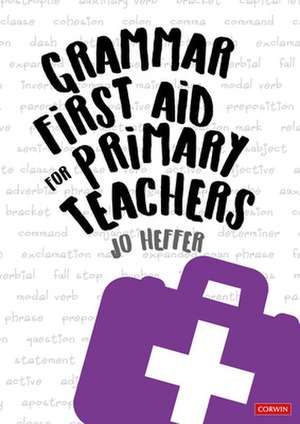Grammar First Aid for Primary Teachers
Autor Jo Hefferen Limba Engleză Paperback – 4 oct 2020
Relative clauses?
Perfect tenses?
Subjunctive form?
How can teachers teach all the grammar and punctuation requirements in the primary National Curriculum in a way that pupils want to learn about them?
This book provides clear explanations, structured introductory teaching sequences and practical consolidation activities that cover all KS2 statutory requirements and makes learning memorable.
Preț: 226.54 lei
Nou
Puncte Express: 340
Preț estimativ în valută:
43.35€ • 44.97$ • 36.15£
43.35€ • 44.97$ • 36.15£
Carte disponibilă
Livrare economică 06-20 martie
Livrare express 19-25 februarie pentru 29.93 lei
Preluare comenzi: 021 569.72.76
Specificații
ISBN-13: 9781529730432
ISBN-10: 1529730430
Pagini: 192
Dimensiuni: 210 x 297 x 14 mm
Greutate: 0.45 kg
Ediția:1
Editura: SAGE Publications
Colecția Corwin UK
Locul publicării:London, United Kingdom
ISBN-10: 1529730430
Pagini: 192
Dimensiuni: 210 x 297 x 14 mm
Greutate: 0.45 kg
Ediția:1
Editura: SAGE Publications
Colecția Corwin UK
Locul publicării:London, United Kingdom
Cuprins
Introduction
Part 1 The Basics: Building on KS1 and EYFS
1.1 Words
1.2 Sentences, texts and punctuation
Part 2 Teaching grammar in years 3 and 4
2.1 A Framework for teaching the Year 3/4 statutory requirements
2.2 Extending the range of sentences with more than one clause by using a wider range of conjunctions, including when, if, because, although
2.3 Using the present perfect form of verbs in contrast to the past tense
2.4 Choosing nouns or pronouns appropriately for clarity and cohesion and to avoid repetition
2.5 Using conjunctions, adverbs and prepositions to express time and cause
2.6 Using fronted adverbials and Using commas after fronted adverbials
2.7 Year 3 and 4 punctuation
Part 3 Teaching grammar in years 5 and 6
3.1 The Y5/6 statutory requirements
3.2 Recognising vocabulary and structures that are appropriate for formal speech and writing, including subjunctive forms
3.3 Using passive verbs to affect the presentation of information in a sentence
3.4 Using the perfect form of verbs to mark relationships of time and cause
3.5 Using expanded noun phrases to convey complicated information concisely
3.6 Using modal verbs or adverbs to indicate degrees of possibility
3.7 Using relative clauses beginning with who, which, where, when, whose, that or using an implied (i.e. omitted) pronoun
3.8 Year 5 and 6 punctuation
Part 4 You’ve taught it but have they learnt it?
Finding Examples in Reading - Book list
A glossary of terms
Part 1 The Basics: Building on KS1 and EYFS
1.1 Words
1.2 Sentences, texts and punctuation
Part 2 Teaching grammar in years 3 and 4
2.1 A Framework for teaching the Year 3/4 statutory requirements
2.2 Extending the range of sentences with more than one clause by using a wider range of conjunctions, including when, if, because, although
2.3 Using the present perfect form of verbs in contrast to the past tense
2.4 Choosing nouns or pronouns appropriately for clarity and cohesion and to avoid repetition
2.5 Using conjunctions, adverbs and prepositions to express time and cause
2.6 Using fronted adverbials and Using commas after fronted adverbials
2.7 Year 3 and 4 punctuation
Part 3 Teaching grammar in years 5 and 6
3.1 The Y5/6 statutory requirements
3.2 Recognising vocabulary and structures that are appropriate for formal speech and writing, including subjunctive forms
3.3 Using passive verbs to affect the presentation of information in a sentence
3.4 Using the perfect form of verbs to mark relationships of time and cause
3.5 Using expanded noun phrases to convey complicated information concisely
3.6 Using modal verbs or adverbs to indicate degrees of possibility
3.7 Using relative clauses beginning with who, which, where, when, whose, that or using an implied (i.e. omitted) pronoun
3.8 Year 5 and 6 punctuation
Part 4 You’ve taught it but have they learnt it?
Finding Examples in Reading - Book list
A glossary of terms
Notă biografică
Jo Heffer has worked as a teacher, literacy subject leader and education consultant for thirty years. She currently works part time for Windsor and Maidenhead as an advisor and assessment manager alongside working as an independent literacy consultant. Her passion for literacy has taken her to many parts of England to run successful courses on teaching grammar and punctuation as well as all other aspects of literacy.
Descriere
This book offers practical advice and guidance for teaching primary grammar, linked to the National Curriculum.
